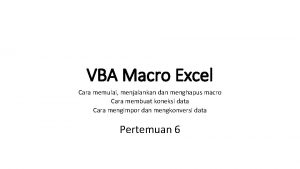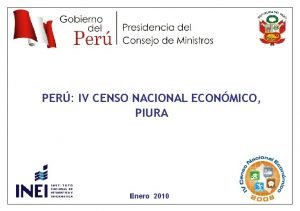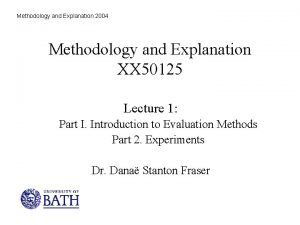Methodology and Explanation 2007 Methodology and Explanation XX

















- Slides: 17

Methodology and Explanation 2007 Methodology and Explanation XX 50125 Lecture 5: Ethnography Dr. Danaë Stanton Fraser

Methodology and Explanation 2007 Ethnography by date • Anthropology (c. 1920 s) – e. g. E. E. Evans Pritchard • Workplaces (c. 1950 s) – Chicago School – E. C. Hughes, Becker etc. • Computer-Supported Cooperative Work (c. 1990 s) – J. Hughes, C. Heath

Methodology and Explanation 2007 Ethnography • Long history with its roots in anthropology • Is ethnography a method? – NOT a methodology! – does not predefine a theoretical or conceptual status – has been used in support of many methodological standpoints, e. g. .

Methodology and Explanation 2007 Ethnography by theory • Ethnography has been used to support: – Soft Systems analysis – Participative design – Activity theory – Cognitive task analysis – Distributed cognition – Ethnomethodology

Methodology and Explanation 2007 Ethnography basics (1) • • assume human activities are socially organised commit to inquiring into patterns of interaction go into the field ‘learn the ropes’ (question, listen, watch, talk, etc. , with practitioners) • take your time • write a report

Methodology and Explanation 2007 Ethnography basics (2) • Ethnography is naturalistic – studies should be studies of real people and their activities, operating in their natural environment – doesn’t deal with artificial worlds & controlled versions of work • but what is ‘artificial’? – Mike Lynch: "Stop talking about science. Go to a laboratory - any laboratory will do - hang around a while, listen to conversations, watch the technicians at work, ask them to explain what they are doing, read their notes, observe what they say when they examine data, and watch how they move equipment around. . . "

Methodology and Explanation 2007 Ethnography basics (3) • Ethnography understands the world from the point of view of those who inhabit it – it is behavioural, i. e. interested in the detail of the behaviour to a greater or lesser extent – it is not behaviourist, i. e. it does not consider the behaviour itself as the appropriate level of analysis

Methodology and Explanation 2007 Ethnography basics (4) • Ethnographic data can include: • general descriptions of behaviours, descriptions of physical layouts, close descriptions of conversation, thoughts and feelings, work sequences, anecdotes, examples, common occurrences etc. – analysis is skilful (but not complex) – ethnographer usually provides 'examples'

Methodology and Explanation 2007 Carrying out an ethnographic study (1) • individuals and organisations have ideas, expectations and fears about ethnography • Gaining access and an ability to be simultaneously likeable and anonymous will help • Gaining acceptance may include working, sharing conditions, a non-intrusive manner, sharing dress codes, but not sharing opinions unless absolutely necessary

Methodology and Explanation 2007 Carrying out an ethnographic study(2) • Initial phase includes: – familiarising yourself with the situation – collect information that you are exposed to – make notes on everything that you see and hear – sketch plans of spaces – tape record

Methodology and Explanation 2007 Carrying out an ethnographic study (3) • Choice between the innocent ethnography and informed ethnography • How theoretically/strategically informed should you be at the outset? • One choice is progression from one to the other

Methodology and Explanation 2007 Technology support for ethnography (1) • Technologies mostly used for data collection • Questions, notebook, pen • Tape recording – less intrusive than video but data is less detailed – awareness of being recorded not a problem – useful to record long explanations, especially highly technical or domain-specific kinds • Probes (Mark Rouncefield et al. )

Methodology and Explanation 2007 Technology support for ethnography (2) • Video – Data can be analysed repeatedly off-site – Time-consuming data collection and analysis – Difficulty setting up and using equipment in some domains – Missing visual actions that are peripheral to the video field-of-view • Programs to support analysis – e. g. Ethnograph, NUDIST

Methodology and Explanation 2007 Ethnography for design • Ethnography used to generate requirements – Detailed reports – Ethnographers as part of a design team – Ethnographers partnering with programmers

Methodology and Explanation 2007 Consecutive v concurrent ethnography for design • Sequenced process • Ethnographic study precedes system development • Thorough insight into the subtleties of the organisation • Declining rate of usefulness for fieldwork to contribute to design • Concurrent process • Ethnographic study goes hand-in-hand with system development • Highlights key surface features of organisation • High contribution of fieldwork to design per hour spent

Methodology and Explanation 2007 Example studies Heath and Luff (1992), Crisis Management and Multimedia Technology in London Underground Line Control Rooms, CSCW journal, 1 (1 -2) – Peripheral monitoring – Designing actions for their visibility by others – Technologies in public workplaces • External speakers – 2 differing examples

Methodology and Explanation 2007 References • • • Cheverst, K. , Dix, A. , Fitton, D. , Friday, A. , Rouncefield, M. Exploring the Utility of Remote Messaging and Situated Office Door Displays. Mobile HCI 2003: 336341 Crabtree, A. (2003) Designing Collaborative Systems: A Practical Guide to Ethnography, London: Springer-Verlag Heath, C. C. , Hindmarsh, J. & P. Luff. (1999) Isolation and interaction: the fragmented world of the train driver on London Underground. Sociology 33, 3, pp. 555 -575 Heath, C. C. and P. Luff (2000) Technology in Action Cambridge: Cambridge University Press. pp 1 -269. Hemmings T, Crabtree A, ( 2002 ) Ethnography for design? . The 1 st International Workshop on "Interpretive" Approaches to Information Systems, pages 122 --124. Association of Information Systems Hughes, J. A. , King, V. , Rodden, T. , and Andersen, H. (1994) "Moving out from the control room: Ethnography in system design". In Proceedings of CSCW ‘ 94, Chapel Hill, North Carolina.
 Sale of goods and supply of services act 2007
Sale of goods and supply of services act 2007 Marzano taxonomy chart
Marzano taxonomy chart Stevenson and black 2007 inclusion spectrum
Stevenson and black 2007 inclusion spectrum Management by stephen p robbins 9th edition
Management by stephen p robbins 9th edition Medicare medicaid and schip extension act of 2007
Medicare medicaid and schip extension act of 2007 Biochemistry sixth edition 2007 w.h. freeman and company
Biochemistry sixth edition 2007 w.h. freeman and company What are the 12 core values?
What are the 12 core values? Cara mengaktifkan macro di excel 2007
Cara mengaktifkan macro di excel 2007 Regression analysis excel 2007
Regression analysis excel 2007 Mental health act 2007 summary
Mental health act 2007 summary Delhi fire service act
Delhi fire service act Df 23/2007
Df 23/2007 12 oktober 2007
12 oktober 2007 Ogle 2007 blg 368 lb
Ogle 2007 blg 368 lb Exercises for microsoft word
Exercises for microsoft word June 2007 physics regents answers
June 2007 physics regents answers Power pivot 2007
Power pivot 2007 Inei censo 2007 resultados
Inei censo 2007 resultados

































